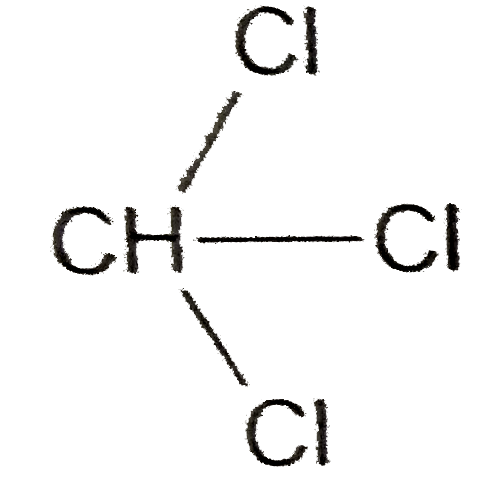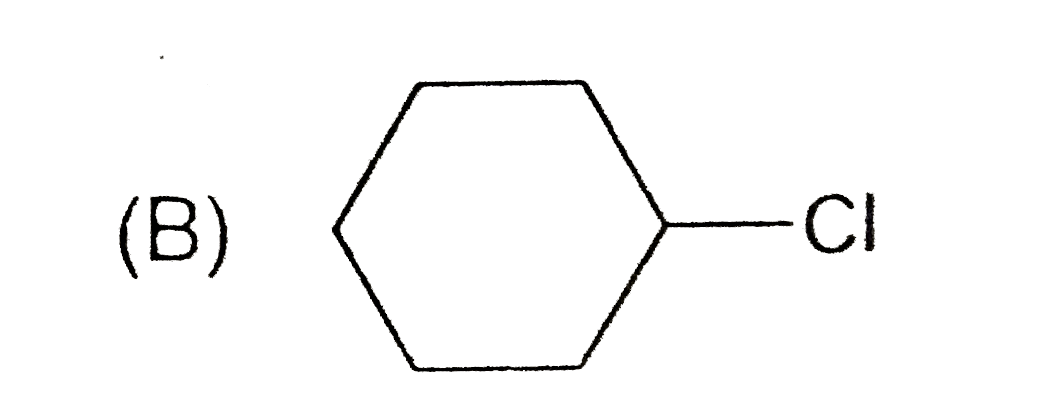In which of the following compound, chlorinie exerts the maximum number of electronic effects ?


CH2=CH−CH2Cl
Chlorobenzene
The correct Answer is:D
To determine in which compound chlorine exerts the maximum number of electronic effects, we need to analyze the electronic effects that chlorine can exert in different compounds. Chlorine can exert two main types of electronic effects:
1. Inductive Effect (−I effect): This is an electron-withdrawing effect due to the electronegativity of chlorine.
2. Mesomeric Effect (+M effect): This is an electron-donating effect that occurs through resonance, particularly in aromatic compounds.
Now, let's analyze each option provided:
Step 1: Analyze the Compounds
Option A: Chloroform (CHCl3)
- Structure: CHCl3 has three chlorine atoms attached to a carbon atom.
- Effects: Chlorine will exert a strong −I effect due to its electronegativity, but there is no resonance effect since it is not an aromatic compound. Thus, only the −I effect is present.
Option B: Cyclohexyl Chloride
- Structure: Cyclohexyl chloride has one chlorine atom attached to a cyclohexane ring.
- Effects: Chlorine will exert a −I effect, but again, there is no resonance effect since it is not an aromatic compound. The −I effect will be less than in chloroform due to only one chlorine atom.
Option C: 3-Chloropropene (CH2=CH-CH2Cl)
- Structure: This compound has a chlorine atom attached to a carbon that is part of a double bond.
- Effects: Chlorine will exert a −I effect, and there is some resonance due to the double bond, but it is still limited compared to aromatic systems. So, it has both −I and limited +M effects.
Option D: Chlorobenzene
- Structure: Chlorobenzene has a chlorine atom attached to a benzene ring.
- Effects: In chlorobenzene, chlorine can exert both −I and +M effects. The lone pair of electrons on chlorine can participate in resonance with the aromatic ring, leading to significant +M effects. The −I effect is also present due to the electronegativity of chlorine.
Step 2: Compare the Effects
- Chloroform: Only −I effect.
- Cyclohexyl Chloride: Only −I effect, less than chloroform.
- 3-Chloropropene: −I effect and limited +M effect.
- Chlorobenzene: Both −I and +M effects are significant due to resonance.
Conclusion
Chlorobenzene exhibits the maximum number of electronic effects because it has both strong −I and +M effects due to its aromatic nature.
Final Answer
Chlorobenzene (Option D) exerts the maximum number of electronic effects.
---
2. Mesomeric Effect (+M effect): This is an electron-donating effect that occurs through resonance, particularly in aromatic compounds.
- Structure: CHCl3 has three chlorine atoms attached to a carbon atom.
- Effects: Chlorine will exert a strong −I effect due to its electronegativity, but there is no resonance effect since it is not an aromatic compound. Thus, only the −I effect is present.
- Structure: Cyclohexyl chloride has one chlorine atom attached to a cyclohexane ring.
- Effects: Chlorine will exert a −I effect, but again, there is no resonance effect since it is not an aromatic compound. The −I effect will be less than in chloroform due to only one chlorine atom.
- Structure: This compound has a chlorine atom attached to a carbon that is part of a double bond.
- Effects: Chlorine will exert a −I effect, and there is some resonance due to the double bond, but it is still limited compared to aromatic systems. So, it has both −I and limited +M effects.
- Structure: Chlorobenzene has a chlorine atom attached to a benzene ring.
- Effects: In chlorobenzene, chlorine can exert both −I and +M effects. The lone pair of electrons on chlorine can participate in resonance with the aromatic ring, leading to significant +M effects. The −I effect is also present due to the electronegativity of chlorine.
- Chloroform: Only −I effect.
- Cyclohexyl Chloride: Only −I effect, less than chloroform.
- 3-Chloropropene: −I effect and limited +M effect.
- Chlorobenzene: Both −I and +M effects are significant due to resonance.
Chlorobenzene exhibits the maximum number of electronic effects because it has both strong −I and +M effects due to its aromatic nature.
Chlorobenzene (Option D) exerts the maximum number of electronic effects.
Similar Questions
Knowledge Check
Which of the following contains the maximum number of unpaired electrons?
AMn2+BCo3+CCo2+DFe2+
Which of the follownig complexes have a maximum number of unpaired electrons?
View SolutionWhich of the following contains the maximum number of unpaired electrons?
View SolutionWhich of the following compound has maximum number of primary H-atoms?
View SolutionWhich of the following compound have maximum number of
olefinic bond :-
View SolutionMaximum number of electrons in the M shell
View SolutionWhich of the following gaseous ion contains maximum number of unpaired electrons ?
View SolutionMaximum number of electrons in nth shell is
View Solution
